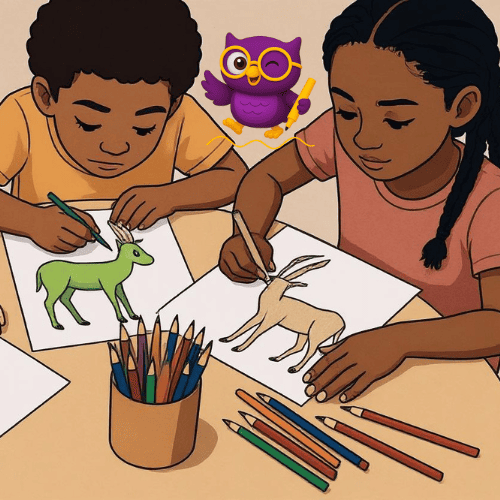
Looking for something fast, fun, and totally horn-tastic? You’ve just leaped into the right place! Our antelope coloring pages are so energetic, they practically jump off the paper—okay, not literally (we promise they won’t run away with your crayons). From zig-zagging hooves to twisty horns, these 30 free printable sheets are packed with wild style and coloring joy. Perfect for little artists, future zoologists, or anyone who thinks antelopes are just fancy deer with better hair. Grab your markers, channel your inner gazelle, and let’s get antelope-ing!
ADVERTISEMENT
ADVERTISEMENT
ADVERTISEMENT
ADVERTISEMENT
ADVERTISEMENT
ADVERTISEMENT
ADVERTISEMENT
ADVERTISEMENT
That means many different-looking animals are called antelopes—even though they don’t form a single scientific group. Coloring them helps kids see this variety for themselves.
ADVERTISEMENT
ADVERTISEMENT
ADVERTISEMENT
Did you enjoy these Antelope Coloring Pages?
We’d love to hear from you! 💬
Share your thoughts, suggestions, or tell us what you’d like to see next!
Antelope coloring pages offer more than just artistic fun—they help develop fine motor skills, improve hand-eye coordination, and foster focus and patience. Coloring encourages kids to pay attention to detail and practice staying within lines, strengthening their pencil grip and pre-writing abilities. It also stimulates creativity, allowing children to explore colors and textures freely while engaging with nature-themed content.
This set includes 30 free antelope coloring pages, all available as high-quality PDF files. These printable sheets feature a variety of antelope types and styles—ranging from simple outlines for younger children to more detailed designs for older kids. They’re perfect for classrooms, homeschool units, rainy-day activities, or even animal-themed birthday parties.
These coloring pages are suitable for a wide range of age groups. Toddlers and preschoolers can enjoy the simpler designs with thick lines, while older children (ages 6–10+) will find the more detailed antelope illustrations engaging and challenging. Teachers and parents can select pages based on the child’s developmental level, interests, or curriculum goals.
Absolutely! Antelope coloring sheets can complement lessons in biology, geography, ecosystems, and even language arts. Educators can pair the coloring pages with fact cards, map activities showing where antelopes live, or storytelling exercises where students imagine a day in the life of an antelope. These pages are a creative and accessible way to make learning about animals fun and memorable.
Though they look similar, antelopes and deer are quite different. The key difference lies in their horns—antelopes have permanent horns that they keep for life, while deer have antlers that they shed and regrow each year. Antelopes also belong to a broader group called Bovidae, which includes goats and sheep, whereas deer belong to the Cervidae family. Coloring pages help kids learn these distinctions through observation and visual learning.
Antelopes are primarily found across Africa and Asia, with a few species living in parts of North America. They inhabit savannas, grasslands, woodlands, and even deserts and mountains. Different species are adapted to different environments, and coloring these animals in context helps children understand how habitat influences an animal’s behavior, diet, and survival strategies.
Antelope coloring pages can be used in many creative ways—turn them into greeting cards, cut them out for bulletin board displays, or use them as part of a themed week like “Savanna Safari” or “Animal Adaptations.” You can also turn the coloring session into a scavenger hunt, where kids find antelope facts or compare horn shapes. They’re also great for quiet time, group coloring contests, or cross-curricular activities combining art and science.
Yes, coloring is known to have calming effects on children. The repetitive motion of coloring, combined with the concentration it requires, helps reduce stress and anxiety. For energetic or overstimulated children, antelope coloring pages can provide a focused, peaceful activity that soothes the mind and encourages mindfulness—especially after active play or screen time.
While the coloring pages are optimized for printing, they can also be imported into digital drawing apps like Procreate, Microsoft Paint, or Adobe Fresco. This makes them accessible for tablet use with a stylus, allowing kids who prefer digital interaction to still enjoy the activity. Whether printed or used digitally, the learning and creativity benefits remain the same.
Here’s a fun collection of key facts about antelopes that kids will love to learn while coloring:
There are over 90 species of antelope in the world.
Some antelopes, like the royal antelope, are tiny—just 10 inches tall.
The giant eland is the largest antelope, weighing over 2,000 pounds.
Antelopes have permanent horns—unlike deer that shed antlers.
Some species can run over 60 mph to escape predators.
Impala antelopes can leap more than 10 feet high.
Antelope eyes are on the sides of their heads, giving them wide vision to spot danger.
Many live in herds and migrate long distances for food and water.
They are herbivores, meaning they only eat plants.
Antelopes play an important role in their ecosystem by grazing and helping control vegetation.
These facts can be shared during coloring sessions or used as fun quiz prompts to make the experience even more interactive.